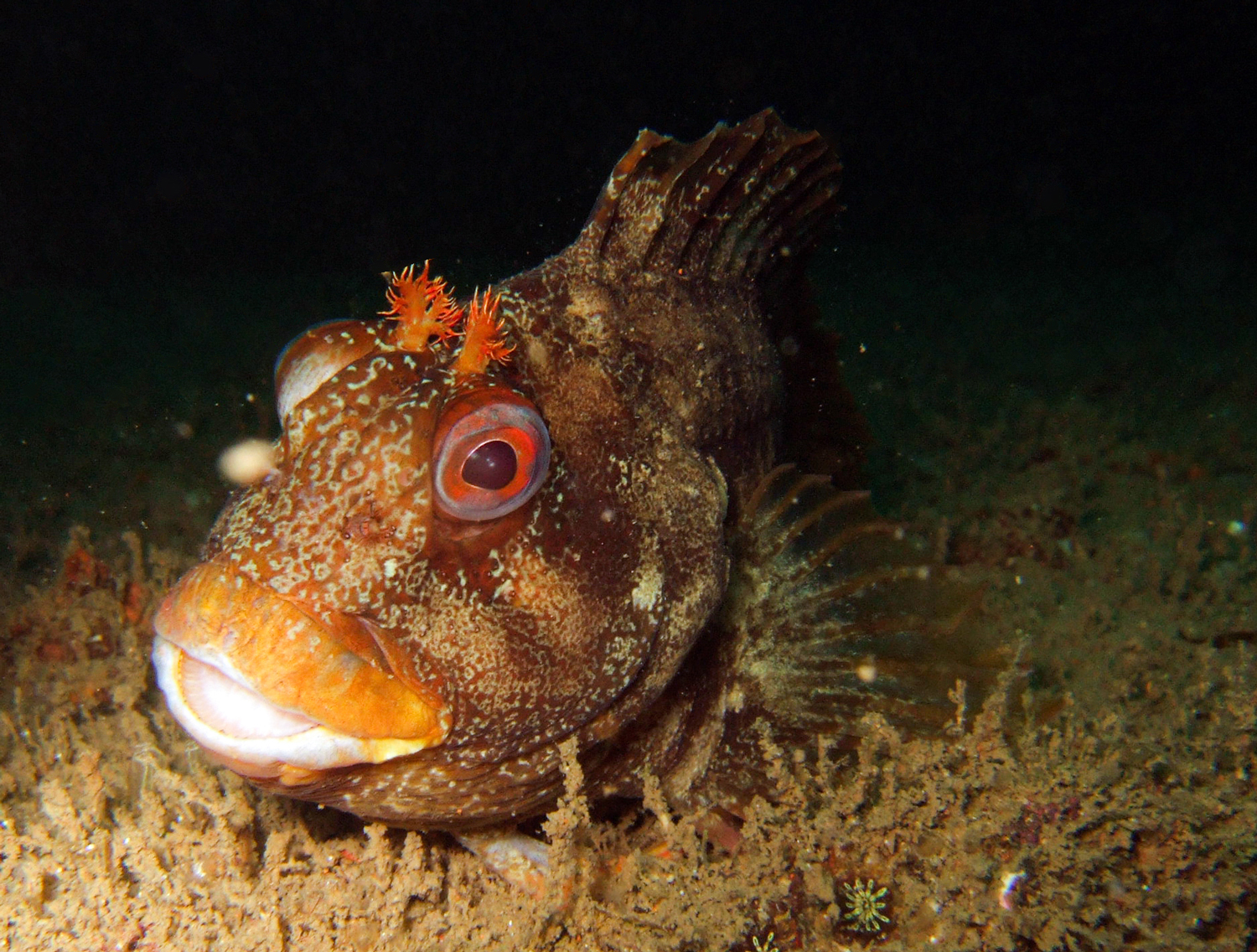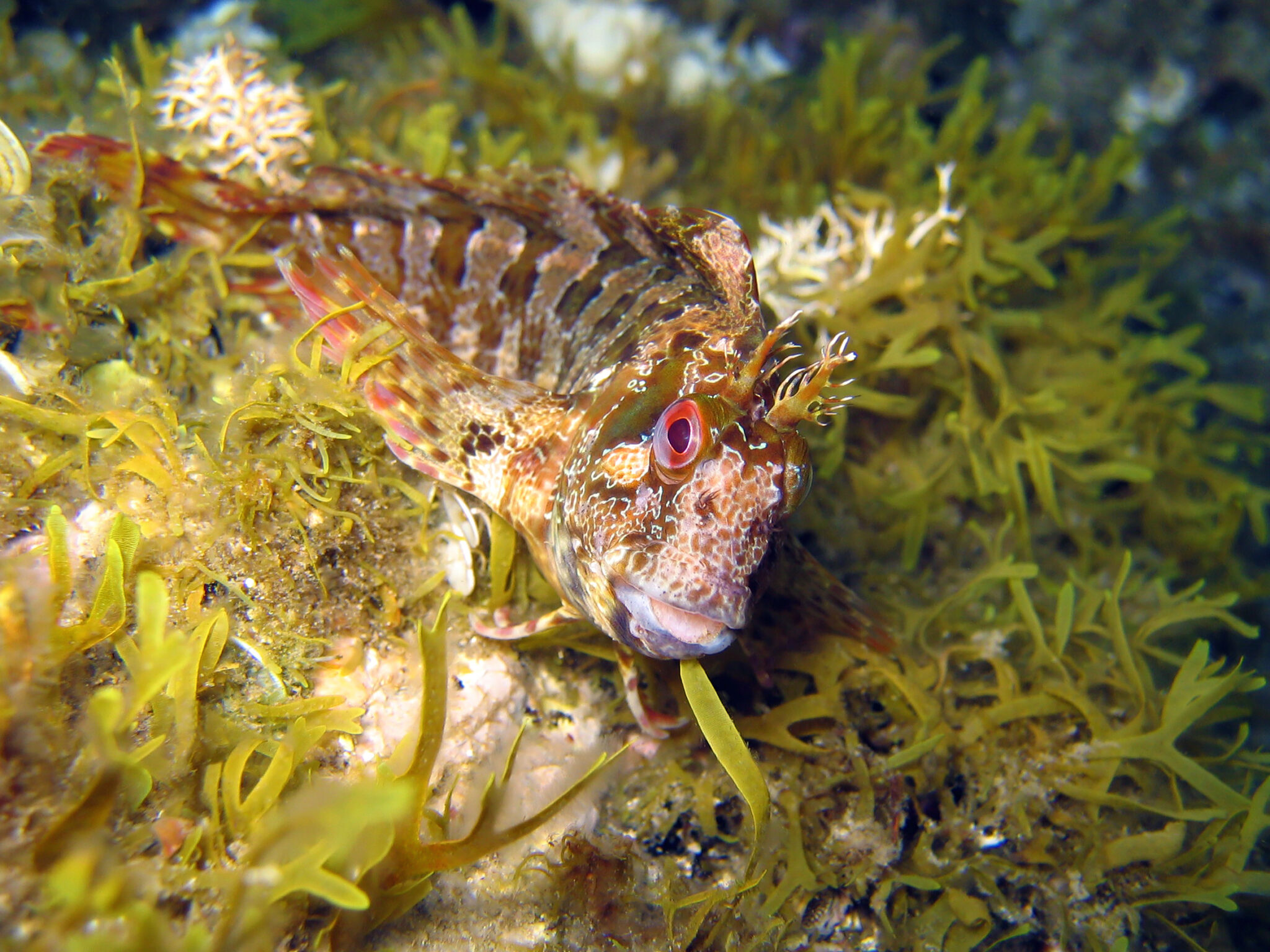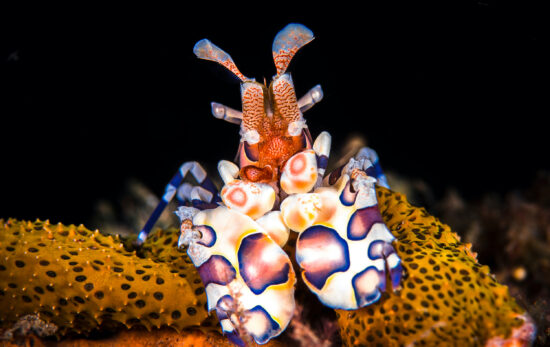Tompot blennies are undoubtedly a staple of British diving. Their cheerful faces are photographers’ favourites and a cover icon for the much-loved Great British Marine Animals. The book’s author, Paul Naylor, has been studying tompot blennies for over a decade — and recently spoke to PADI AmbassaDiver Miranda Krestovnikoff about his fascination and findings.
In this blog, we dive deeper into the behaviour of this comical species and find out what Paul loves so much about the wonderful tompot blenny and UK diving.

What’s a tompot blenny?
The tompot blenny (Parablennius gattorugine) is a common fish living close to shorelines and one of 900 blenny species (blenniiformids). Peeking out of shallow rocky crevices or wrecks, these photogenic critters are instantly recognisable with their wide grin, big eyes, and the two giant antlers (OK, tentacles) on top of their head. Almost eel-like, these bottom-dwellers wriggle – with surprising speed – rather than swim.
Size: Up to 30cm (12 inches)
Diet: Sea anemones, prawns, crustaceans
Depth: 3-32m (10-105ft)
When: Year-round
Where: Western Europe, Mediterranean, North Africa
What’s in a name?
Blenny comes from the Greek for slime. Gattorugine dates back to 17th Century Venice; it’s the mishearing of gotto rosula, which stems from the Italian for ‘thick throat’.
The tompot blennies of Wembury, UK
Over ten years ago, marine biologist Paul Naylor discovered that tompot blennies could be identified by unique face markings. This opened up endless possibilities for studying the behaviours of these charismatic creatures.
“Showing people the appealing countenance of tompot blennies, and describing the intricacies of their behaviour, is an excellent way of introducing the fascination and beauty of our marine life.” – Paul Naylor, The Lives and Times of Tompot Blennies
In an exclusive interview with PADI AmbassaDiver Miranda Krestovnikoff, Paul talks about his blenny obsession, UK scuba diving, and some of his discoveries:
In 2021, Paul published a paper focusing on a small reef and conservation area in Wembury Bay, Devon. Featured in The Guardian and BBC Wildlife, among others, his research shines a light on the ‘Lives and Times’ of nearly 50 individual tompot blennies…
Tompot territory
Like other blennies, male tompots are incredibly territorial. The best crevices make the best (and safest) breeding spots — so there’s tough competition! Challenges from intruders lead to ‘standoffs’ and battle scars, but champions might keep their favourite spot for many years.
Tompot courtship
If you think Love Island is complicated, then try the tompot dating scene:
It’s promiscuous: During the breeding season (March-June), females lay eggs with many males, while males play host to several females… sometimes two at a time!
It’s sneaky: Paul Naylor’s research witnessed ‘sneaker males’ trying to fertilise other males’ eggs — ninja style — with no intention of sticking around afterwards.
It’s competitive: With limited egg space and huge paternal demands, it’s no surprise that male tompots are picky. This selectiveness creates fierce competition between the ladies!
Tompot parenting
Female tompots lay demersal eggs on the floor or ceiling of a winning crevice. The precise location is often influenced by nudges and nips from the male, who might have multiple batches at different stages of development. But, if there’s no space, she might leave without laying at all. Once the female moves on, Dad is left guarding his own brood — the same as other blenny species.
Ever the doting male parent, he chases away predators such as crabs or clingfish, removes debris, and wipes eggs with special anal glands to keep them healthy. It’s a hard job, lasting about a month until the larvae hatch. But, over seven years of research, not a single male abandoned his eggs. That’s commitment!

The pecking order
Tompot blennies change behaviour depending on who’s nearby, suggesting a hierarchy in their community. Submission includes rolling over, while dominant individuals might bite seaweed or even push shells around! Although not camouflaged, they can even change colour: darker if dominant, or paler when submissive.
Even more tompot blenny facts…
- Research suggests tompots live for at least five years, perhaps longer
- Gender isn’t obvious (you’ll have to spot a male’s anal glands during breeding season)
- Juveniles battle for territory at just a couple of months old
- After winter, males ‘spring clean’ their crevices before breeding season starts
- Tompots have individual personalities: they can be shy, curious, bold, or grumpy!
Dive into the UK
The UK is one of the world’s best places to see tompot blennies — head to dive sites along the south or west coast and you won’t need to search far. The ruggedly beautiful coastline is bustling with underwater life, from invertebrates like sea stars, nudibranchs, jellyfish, and octopuses to crustaceans, conger eels, seahorses, and hundreds of fish species. There are seals, dolphins, whales, and yes — even sharks. Or, if history is more your style, you still won’t be disappointed; there are at least 50,000 shipwrecks scattered around the British Isles.
Whether you’re a keen photographer or underwater naturalist, you’ll want to meet the tompot blenny. Book your UK scuba diving trip today!





